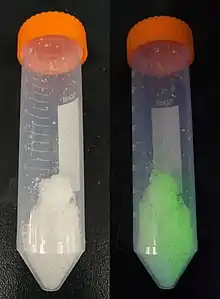Terbium(III) nitrate
Terbium(III) nitrate is an inorganic chemical compound with the formula Tb(NO3)3. The hexahydrate crystallizes as triclinic colorless crystals with the formula [Tb(NO3)3(H2O)4]·2H2O.[1] It can be used to synthesize materials with green emission.[2]
 Hydrate form of terbium nitrate (left) and luminescence under 254 nm UV light (right) | |
| Names | |
|---|---|
| Other names
Terbium nitrate | |
| Identifiers | |
| |
3D model (JSmol) |
|
| ECHA InfoCard | 100.030.113 |
PubChem CID |
|
| UNII | |
CompTox Dashboard (EPA) |
|
| |
| |
| Properties | |
| Tb(NO3)3 | |
| Molar mass | 344.946 |
| Appearance | Colorless crystals (hexahydrate)[1] |
Except where otherwise noted, data are given for materials in their standard state (at 25 °C [77 °F], 100 kPa). | |
| Infobox references | |
Preparation
Terbium(III) nitrate can be prepared by dissolving terbium(III,IV) oxide in a mixture of aqueous HNO3 and H2O2 solution.[3]
Properties
It reacts with NH4HCO3 to produce Tb2(CO3)3 along with its basic carbonate.[4] It forms Tb(NO3)52- in CH3CN with excess nitrate anions.[5]
References
- Moret, Emmanuel; Bünzli, Jean-Claude G.; Schenk, Kurt J. (1990). "Structural and luminescence study of europium and terbium nitrate hexahydrates". Inorganica Chimica Acta. 178 (1): 83–88. doi:10.1016/S0020-1693(00)88138-4. ISSN 0020-1693.
- Xia, Tifeng; Song, Tao; Zhang, Gege; Cui, Yuanjing; Yang, Yu; Wang, Zhiyu; Qian, Guodong (2016). "A Terbium Metal-Organic Framework for Highly Selective and Sensitive Luminescence Sensing of Hg2+Ions in Aqueous Solution". Chemistry - A European Journal. 22 (51): 18429–18434. doi:10.1002/chem.201603531. ISSN 0947-6539. PMID 27747951.
- Hou, Zhiyao; Wang, Lili; Lian, Hongzhou; Chai, Ruitao; Zhang, Cuimiao; Cheng, Ziyong; Lin, Jun (2009). "Preparation and luminescence properties of Ce3+ and/or Tb3+ doped LaPO4 nanofibers and microbelts by electrospinning". Journal of Solid State Chemistry. 182 (4): 698–708. Bibcode:2009JSSCh.182..698H. doi:10.1016/j.jssc.2008.12.021. ISSN 0022-4596.
- Foger, K.; Hoang, M.; Turney, T. W. (1992). "Formation and thermal decomposition of rare-earth carbonates". Journal of Materials Science. 27 (1): 77–82. Bibcode:1992JMatS..27...77F. doi:10.1007/BF02403646. ISSN 0022-2461. S2CID 189835444.
- Bünzli, Jean-Claude G.; Vuckovic, Milan M. (1983). "Spectroscopic properties of anhydrous and aqueous solutions of terbium perchlorate and nitrate: Coordination numbers of the Tb(III) ion". Inorganica Chimica Acta. 73: 53–61. doi:10.1016/S0020-1693(00)90826-0. ISSN 0020-1693.
| HNO3 | He | ||||||||||||||||
| LiNO3 | Be(NO3)2 | B(NO 3)− 4 |
RONO2 | NO− 3 NH4NO3 |
HOONO2 | FNO3 | Ne | ||||||||||
| NaNO3 | Mg(NO3)2 | Al(NO3)3 | Si | P | S | ClONO2 | Ar | ||||||||||
| KNO3 | Ca(NO3)2 | Sc(NO3)3 | Ti(NO3)4 | VO(NO3)3 | Cr(NO3)3 | Mn(NO3)2 | Fe(NO3)2 Fe(NO3)3 |
Co(NO3)2 Co(NO3)3 |
Ni(NO3)2 | CuNO3 Cu(NO3)2 |
Zn(NO3)2 | Ga(NO3)3 | Ge | As | Se | Br | Kr |
| RbNO3 | Sr(NO3)2 | Y(NO3)3 | Zr(NO3)4 | Nb | Mo | Tc | Ru(NO3)3 | Rh(NO3)3 | Pd(NO3)2 Pd(NO3)4 |
AgNO3 Ag(NO3)2 |
Cd(NO3)2 | In(NO3)3 | Sn | Sb(NO3)3 | Te | INO3 | Xe(NO3)2 |
| CsNO3 | Ba(NO3)2 | Hf(NO3)4 | Ta | W | Re | Os | Ir | Pt(NO3)2 Pt(NO3)4 |
Au(NO3)3 | Hg2(NO3)2 Hg(NO3)2 |
TlNO3 Tl(NO3)3 |
Pb(NO3)2 | Bi(NO3)3 BiO(NO3) |
Po(NO3)4 | At | Rn | |
| FrNO3 | Ra(NO3)2 | Rf | Db | Sg | Bh | Hs | Mt | Ds | Rg | Cn | Nh | Fl | Mc | Lv | Ts | Og | |
| ↓ | |||||||||||||||||
| La(NO3)3 | Ce(NO3)3 Ce(NO3)4 |
Pr(NO3)3 | Nd(NO3)3 | Pm(NO3)3 | Sm(NO3)3 | Eu(NO3)3 | Gd(NO3)3 | Tb(NO3)3 | Dy(NO3)3 | Ho(NO3)3 | Er(NO3)3 | Tm(NO3)3 | Yb(NO3)3 | Lu(NO3)3 | |||
| Ac(NO3)3 | Th(NO3)4 | PaO2(NO3)3 | UO2(NO3)2 | Np(NO3)4 | Pu(NO3)4 | Am(NO3)3 | Cm(NO3)3 | Bk | Cf | Es | Fm | Md | No | Lr | |||
This article is issued from Wikipedia. The text is licensed under Creative Commons - Attribution - Sharealike. Additional terms may apply for the media files.